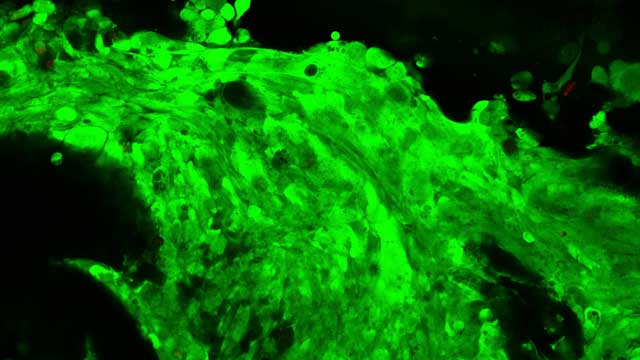3D Printing to Lead Fight Against Brain Tumors

Malignant cells drawn from a tumor. Courtesy of HWU.
Latest News
May 31, 2016
Odds are good you know someone who has been diagnosed with a brain tumor. Personally, I’ve known two different people who have suffered from the disease and while both were able to have the tumor removed, neither operation came without a price. One individual was left physically impaired, requiring years of physical rehab, and the other lost her sense of smell.
The American Brain Tumor Association estimates that around 78,000 cases will be diagnosed each year, while 700,000 individuals are already living with a brain tumor. Scotland’s Heriot-Watt University (HWU) hopes to attack the problem of brain tumors with a new 3D printing technique that allows researchers to build more accurate laboratory tumors.
 Malignant cells drawn from a tumor. Courtesy of HWU.
Malignant cells drawn from a tumor. Courtesy of HWU.While it is already possible to create tumor-like constructs in the lab, these tumors don’t behave in exactly the same manner as tumors that formed inside a human brain.
“We have developed a novel 3D printing technique to print brain tumor cells for the first time, cells that continue to grow rapidly, more closely mimicking the growth of these aggressive tumors in real life,” said Nicholas Leslie, a tumor biologist at the HWU’s Institute of Biological Chemistry, Biophysics and Bioengineering. “Our goal is that this should provide a new way of testing drugs to treat brain tumors, leading to new treatments and speeding up the process by which new drugs become available to patients.”
The new process begins by gathering cell samples from existing tumors to act as manufactured tumor material. Those cells are then printed in three dimensions inside a liquid medium, building up layers until researchers have a viable, active tumor upon which they can experiment. Not only does the new technique offer new directions for research, it also reduces the necessity of animal testing.
Research will begin by examining malignant tumors, particularly glioblastoma, which is among the most common types of aggressive brain tumors in adults. According to Leslie, the new method of manufacturing tumors can speed up research by offering an easier method of testing drug efficacy.
Below you’ll find a short video about the medical applications of 3D printing.
Sources: HWU, American Brain Tumor Association
Subscribe to our FREE magazine, FREE email newsletters or both!
Latest News
About the Author
John NewmanJohn Newman is a Digital Engineering contributor who focuses on 3D printing. Contact him via [email protected] and read his posts on Rapid Ready Technology.
Follow DE





